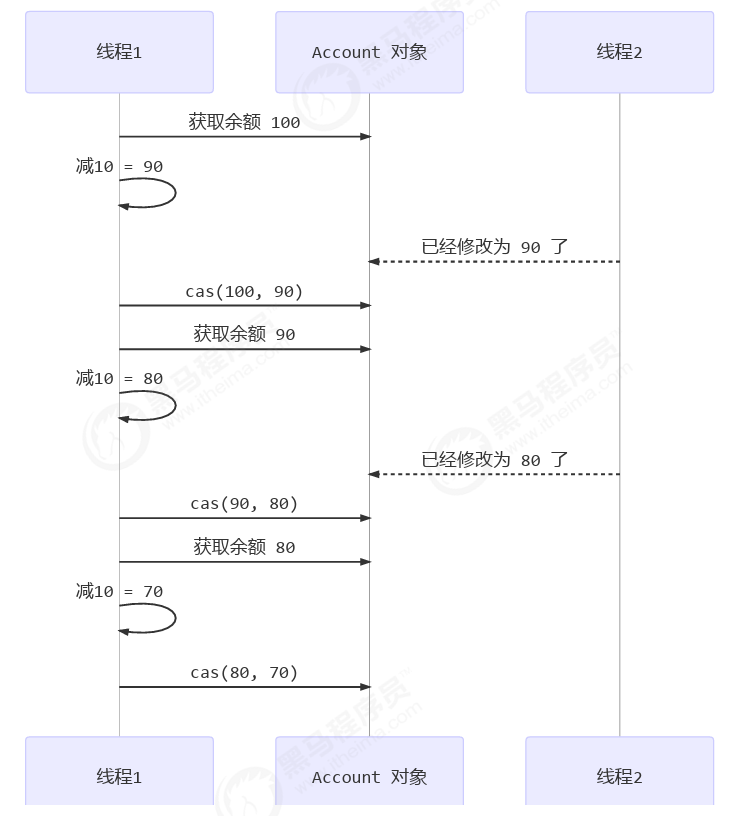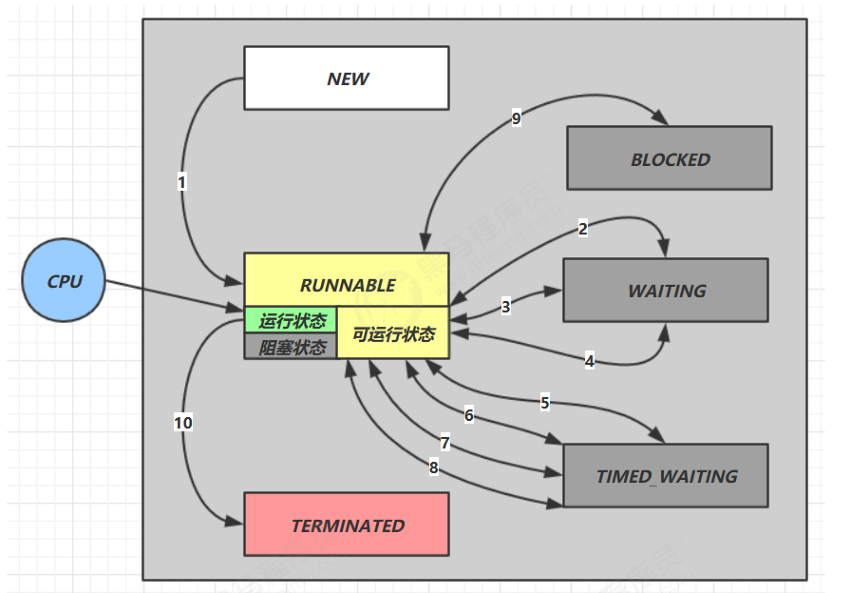java并发编程七 无锁解决加锁问题
发布时间:2023年12月22日
问题提出
有如下需求,保证 account.withdraw 取款方法的线程安全
package cn.onenewcode;
import java.util.ArrayList;
import java.util.List;
interface Account {
// 获取余额
Integer getBalance();
// 取款
void withdraw(Integer amount);
/**
* 方法内会启动 1000 个线程,每个线程做 -10 元 的操作
* 如果初始余额为 10000 那么正确的结果应当是 0
*/
static void demo(Account account) {
List<Thread> ts = new ArrayList<>();
long start = System.nanoTime();
for (int i = 0; i < 1000; i++) {
ts.add(new Thread(() -> {
account.withdraw(10);
}));
}
ts.forEach(Thread::start);
ts.forEach(t -> {
try {
t.join();
}
}
catch (InterruptedException e) {
e.printStackTrace();
});
long end = System.nanoTime();
System.out.println(account.getBalance()
+ " cost: " + (end-start)/1000_000 + " ms");
}
}
原有实现并不是线程安全的
class AccountUnsafe implements Account {
private Integer balance;
public AccountUnsafe(Integer balance) {
this.balance = balance;
}
@Override
public Integer getBalance() {
return balance;
}
@Override
public void withdraw(Integer amount) {
balance -= amount;
}
}
执行测试代码
public static void main(String[] args) {
Account.demo(new AccountUnsafe(10000));
}
某次的执行结果
330 cost: 306 ms
为什么不安全
withdraw 方法
public void withdraw(Integer amount) {
balance -= amount;
}
对应的字节码
ALOAD 0
ALOAD 0
GETFIELD cn/itcast/AccountUnsafe.balance : Ljava/lang/Integer;
INVOKEVIRTUAL java/lang/Integer.intValue ()I
ALOAD 1
INVOKEVIRTUAL java/lang/Integer.intValue ()I
ISUB
// <- this
// <- this.balance
// 拆箱
// <- amount
// 拆箱
// 减法
INVOKESTATIC java/lang/Integer.valueOf (I)Ljava/lang/Integer;
PUTFIELD cn/itcast/AccountUnsafe.balance : Ljava/lang/Integer;
多线程执行流程
// 结果装箱
// -> this.balance
多线程执行流程
// 结果装箱
// -> this.balance
ALOAD 0 // thread-0 <- this
ALOAD 0
GETFIELD cn/onenewcode/AccountUnsafe.balance // thread-0 <- this.balance
INVOKEVIRTUAL java/lang/Integer.intValue // thread-0 拆箱
ALOAD 1 // thread-0 <- amount
INVOKEVIRTUAL java/lang/Integer.intValue // thread-0 拆箱
ISUB // thread-0 减法
INVOKESTATIC java/lang/Integer.valueOf // thread-0 结果装箱
PUTFIELD cn/onenewcode/AccountUnsafe.balance // thread-0 -> this.balance
ALOAD 0 // thread-1 <- this
ALOAD 0
GETFIELD cn/onenewcode/AccountUnsafe.balance // thread-1 <- this.balance
INVOKEVIRTUAL java/lang/Integer.intValue // thread-1 拆箱
ALOAD 1 // thread-1 <- amount
INVOKEVIRTUAL java/lang/Integer.intValue // thread-1 拆箱
ISUB // thread-1 减法
INVOKESTATIC java/lang/Integer.valueOf // thread-1 结果装箱
PUTFIELD cn/onenewcode/AccountUnsafe.balance // thread-1 -> this.balance
- 单核的指令交错
- 多核的指令交错
解决思路-锁
首先想到的是给 Account 对象加锁
class AccountUnsafe implements Account {
private Integer balance;
public AccountUnsafe(Integer balance) {
this.balance = balance;
}
@Override
public synchronized Integer getBalance() {
return balance;
}
}
@Override
public synchronized void withdraw(Integer amount) {
balance -= amount;
}
结果为
0 cost: 399 ms
解决思路-无锁
class AccountSafe implements Account {
private AtomicInteger balance;
public AccountSafe(Integer balance) {
this.balance = new AtomicInteger(balance);
}
@Override
public Integer getBalance() {
return balance.get();
}
@Override
public void withdraw(Integer amount) {
while (true) {
int prev = balance.get();
int next = prev - amount;
// 通过判断前一个和后一个参数是否相同,来判断是否对象是否被更改
if (balance.compareAndSet(prev, next)) {
break;
}
}
// 可以简化为下面的方法
// balance.addAndGet(-1 * amount);
}
}
执行测试代码
public static void main(String[] args) {
Account.demo(new AccountSafe(10000));
}
某次的执行结果
0 cost: 302 ms
CAS 与 volatile
前面看到的 AtomicInteger 的解决方法,内部并没有用锁来保护共享变量的线程安全。那么它是如何实现的呢?
public void withdraw(Integer amount) {
while(true) {
// 需要不断尝试,直到成功为止
while (true) {
// 比如拿到了旧值 1000
int prev = balance.get();
// 在这个基础上 1000-10 = 990
int next = prev - amount;
/*
compareAndSet 正是做这个检查,在 set 前,先比较 prev 与当前值- 不一致了,next 作废,返回 false 表示失败
比如,别的线程已经做了减法,当前值已经被减成了 990
那么本线程的这次 990 就作废了,进入 while 下次循环重试- 一致,以 next 设置为新值,返回 true 表示成功
*/
if (balance.compareAndSet(prev, next)) {
break;
}
}
}
}
其中的关键是 compareAndSet,它的简称就是 CAS (也有 Compare And Swap 的说法),它必须是原子操作。

慢动作分析
@Slf4j
public class SlowMotion {
public static void main(String[] args) {
AtomicInteger balance = new AtomicInteger(10000);
int mainPrev = balance.get();
log.debug("try get {}", mainPrev);
new Thread(() -> {
sleep(1000);
int prev = balance.get();
balance.compareAndSet(prev, 9000);
log.debug(balance.toString());
},
"t1").start();
sleep(2000);
log.debug("try set 8000...");
boolean isSuccess = balance.compareAndSet(mainPrev, 8000);
log.debug("is success ? {}", isSuccess);
if(!isSuccess){
mainPrev = balance.get();
log.debug("try set 8000...");
isSuccess = balance.compareAndSet(mainPrev, 8000);
log.debug("is success ? {}", isSuccess);
}
}
private static void sleep(int millis) {
try {
Thread.sleep(millis);
}
catch (InterruptedException e) {
e.printStackTrace();
}
}
}
输出结果
2023-10-13 11:28:37.134 [main] try get 10000
2023-10-13 11:28:38.154 [t1] 9000
2023-10-13 11:28:39.154 [main] try set 8000...
2023-10-13 11:28:39.154 [main] is success ? false
2023-10-13 11:28:39.154 [main] try set 8000...
2023-10-13 11:28:39.154 [main] is success ? true
volatile
获取共享变量时,为了保证该变量的可见性,需要使用 volatile 修饰。
它可以用来修饰成员变量和静态成员变量,他可以避免线程从自己的工作缓存中查找变量的值,必须到主存中获取它的值,线程操作 volatile 变量都是直接操作主存。即一个线程对 volatile 变量的修改,对另一个线程可见。
CAS 必须借助 volatile 才能读取到共享变量的最新值来实现【比较并交换】的效果
为什么无锁效率高
- 无锁情况下,即使重试失败,线程始终在高速运行,没有停歇,而 synchronized 会让线程在没有获得锁的时候,发生上下文切换,进入阻塞。打个比喻
- 线程就好像高速跑道上的赛车,高速运行时,速度超快,一旦发生上下文切换,就好比赛车要减速、熄火,等被唤醒又得重新打火、启动、加速… 恢复到高速运行,代价比较大
- 但无锁情况下,因为线程要保持运行,需要额外 CPU 的支持,CPU 在这里就好比高速跑道,没有额外的跑道,线程想高速运行也无从谈起,虽然不会进入阻塞,但由于没有分到时间片,仍然会进入可运行状态,还是会导致上下文切换。

CAS 的特点
结合 CAS 和 volatile 可以实现无锁并发,适用于线程数少、多核 CPU 的场景下。
- CAS 是基于乐观锁的思想:最乐观的估计,不怕别的线程来修改共享变量,就算改了也没关系,我吃亏点再重试呗。
- synchronized 是基于悲观锁的思想:最悲观的估计,得防着其它线程来修改共享变量,我上了锁你们都别想改,我改完了解开锁,你们才有机会。
- CAS 体现的是无锁并发、无阻塞并发,请仔细体会这两句话的意思
- 因为没有使用 synchronized,所以线程不会陷入阻塞,这是效率提升的因素之一
- 但如果竞争激烈,可以想到重试必然频繁发生,反而效率会受影响
文章来源:https://blog.csdn.net/studycodeday/article/details/135105474
本文来自互联网用户投稿,该文观点仅代表作者本人,不代表本站立场。本站仅提供信息存储空间服务,不拥有所有权,不承担相关法律责任。 如若内容造成侵权/违法违规/事实不符,请联系我的编程经验分享网邮箱:chenni525@qq.com进行投诉反馈,一经查实,立即删除!
本文来自互联网用户投稿,该文观点仅代表作者本人,不代表本站立场。本站仅提供信息存储空间服务,不拥有所有权,不承担相关法律责任。 如若内容造成侵权/违法违规/事实不符,请联系我的编程经验分享网邮箱:chenni525@qq.com进行投诉反馈,一经查实,立即删除!
最新文章
- Python教程
- 深入理解 MySQL 中的 HAVING 关键字和聚合函数
- Qt之QChar编码(1)
- MyBatis入门基础篇
- 用Python脚本实现FFmpeg批量转换
- 【MATLAB源码-第108期】基于matlab的OFDM-OQAM系统仿真,包含PHYDYAS滤波器模块和PNN结构,输出误码率曲线。
- 积萨伯爵潮流品牌,全品类国际化,新营销创业掀起创业新浪潮
- Redis实现日榜|直播间榜单|排行榜|Redis实现日榜01
- 游泳耳机哪个牌子好,盘点2024最值得购买的游泳耳机
- 如何有效抑制DCDC电源纹波?
- 【Hadoop】 YARN 运行过程/YARN设计目标
- 性价比之王:十几块钱一个月的云主机能干啥
- S7-1200/1500(T) 通过功能块FB38051实现 SINAMICS S200 的 EPOS 基本定位控制
- /*局部变量与静态局部变量的区别*/
- 分布式(10)